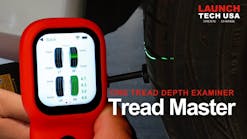While this hopefully is a rarely encountered issue, there is the potential wherein a customer claims that his or her vehicle was “damaged” while at your shop. This might involve a dent, body paint scratches, interior stains, cracked windshield, scuffed alloy wheels, etc. Granted, mishaps can occur during a busy and frantic workday, and the majority of repair shops routinely handle their customers’ vehicles with the utmost in care. But the potential for such a claim is nevertheless real.
In order to protect yourself from such claims, consider performing a simple walk-around of the vehicle when it enters the shop, using the video feature on a smart phone or with a digital camera. Slowly walk around the entire vehicle while video recording the front, driver side, rear and passenger side. Open a door and record the interior (front and rear). Of course, you can go further by taking video or still photos of the engine bay and undercar areas if you like.
Sadly, in some cases, a less-than-honest customer may try to pin (i.e. scam) damage on you in a misguided effort to glean a free repair, while being aware of the issue before driving to your shop. In other cases, an honest but perhaps inattentive customer may not be aware of the damage, but notices it when picking the vehicle up after the requested repairs. (“Gee, it wasn’t like that when I brought it in.”)
Of course, if the damage was indeed caused while the vehicle was in your shop’s possession, you’re liable for it and should see to it that the appropriate repairs are handled. Hopefully your garage keeper’s insurance will cover that. But when an irate customer rants and screams, you’re in a tough spot. In this day and age, we know all too well that one disgruntled customer is able to post their complaints via social media, and naturally that’s something we want to avoid. Being able to show the video or photos can prove that the issue(s) existed when the vehicle arrived.
I recently visited a local Ford dealership and observed a service advisor taking a brief video of each and every vehicle the moment it was pulled into the shop. This was downloaded to the shop’s computer to serve as a per-customer record. Out of curiosity, I asked about the practice and was told they had encountered a few such scam attempts in the past, and had since decided to video every vehicle as a matter of routine. It only takes about a minute to do this, and can prove invaluable if someone makes such a claim.
Tool Organization
How many of us are guilty of tossing our hand tools back into the tool chest after completing a rush job and moving on to the next project? Probably more than we would like to admit. A disorganized toolbox is one of my pet peeves. Without a clear path of organization, we waste time when we search through a messy drawer trying to find that 10mm deep-well socket or that short, stubby screwdriver that we know is the only one that will fit a certain task. Keeping all of our metric socket wrenches and combo wrenches in one drawer, and organized on graduated trays not only creates a professional appearance, it allows quick access to the size/type needed at a moment’s notice. The same goes for inch format wrenches, brake system specialty tools, make hex bits, ratchets, torque wrenches, etc.
Our tools of the trade are not only necessities — without which we couldn’t open the shop doors — they’re our buddies. They're the cohorts that work with us on a daily basis, and the muses to our skills, ambitions and goals to do the best we can on every job. They deserve to be treated with respect.
While it’s often difficult to maintain your tools during a busy and sometimes hectic workday, try to set aside a few minutes at the end of the day — or at least at the end of each week — to not only organize all of the tools in your chest, but clean them as well. Starting the day off with your tools neatly placed and clean is akin to the first coffee of the day — it just makes you feel better.



